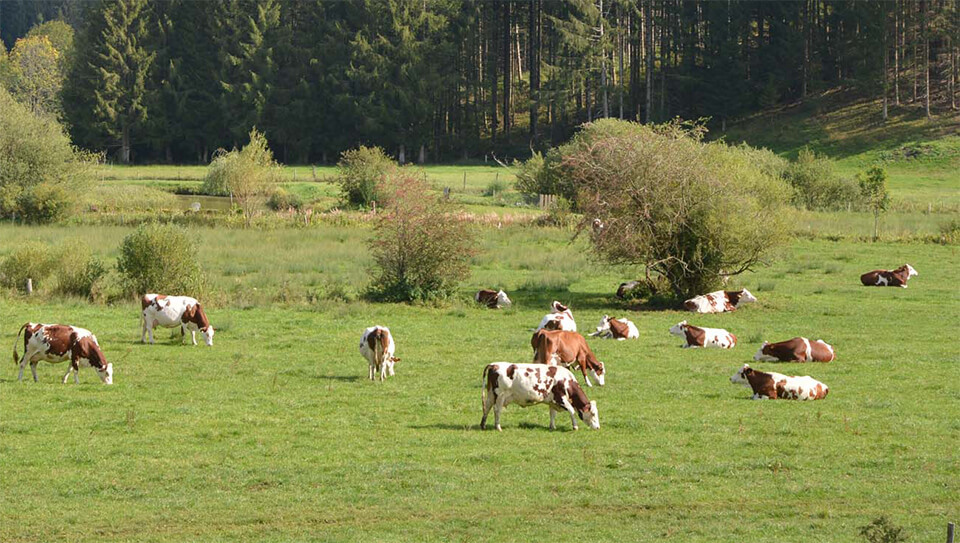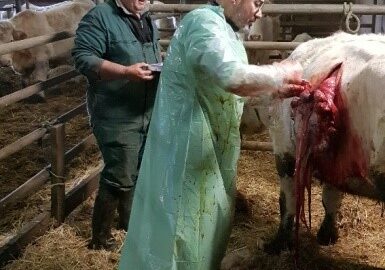Vaccination de rappel avec un vaccin hétérologue : résultats sur la production d’ anticorps anti BTV4 et BTV8 chez des bovins

Auteurs
Résumé
La fièvre catarrhale ovine (FCO), arbovirose causée par le Bluetongue virus (BTV) dont il existe au moins27 sérotypes, s’ est installée en France à partir de 2006. Une campagne de vaccination massive a interrompu la circulationdes souches virales mais la FCO est réapparue en 2015, associée alors à des signes cliniques beaucoup plus frustes. Lespouvoirs publics ont décidé de la nature optionnelle de la vaccination. Cette dernière reste obligatoire pour l’ exportationd’ animaux vivants dans certains pays et des éleveurs continuent de pratiquer la vaccination pour éviter les symptômesassociés à la circulation des souches virales. Dans ce contexte, la problématique s’ est posée d’ utiliser des vaccins différentsde celui employé initialement en primovaccination dans la protection des animaux. Pour cela, un essai clinique a été mené sur 50 vaches laitières appartenant à 3 élevages laitiers du Massif central. Tous ces animaux avaient reçu l’ année précédente une primovaccination (en 2 injections séparées de 3 semaines) avec du BTVPUR bivalent 4+8. En guise de rappel vaccinal, un an après, la moitié a reçu du BTVPUR bivalent 4+8 et l’ autre moitié a reçu du SYVAZUL BTV. La réponse vaccinale a été comparée grâce à l’ emploi de 4 tests sérologiques, 2 tests ELISA, un spécifique à tous les sérotypes de BTV, l’ autre spécifique de BTV4 et 2 tests de séroneutralisations, l’ un mesurant les anticorps séroneutralisants anti BTV4 et l’ autre les anticorps séroneutralisants anti BTV 8. Les résultats montrent que la réponse en anticorps est équivalente entre les deux vaccins sauf pour les anticorps neutralisants anti BTV 8 où la réponse en anticorps au vaccin hétérologue (donc le SYVAZUL BTV) est significativement plus forte. Cet essai ouvre des perspectives intéressantes dans l’ élaboration possible de schémas vaccinaux ne comportant pas toujours exactement le même vaccin.
Abstract
A massive vaccination campaign stopped the circulation of the virus. However, bluetongue reappeared in 2015 and it was associated with milder clinical signs. The public authorities have decided that vaccination is optional. However, vaccination remains compulsory for the exportation of live animals to certain countries, and some farmers continue to vaccinate in order to avoid the symptoms associated with the circulation of viral strains. Within this context, the question arose of using vaccines other than those initially used for primary vaccination to protect animals. In order to answer this question, a clinical trial was carried out on 50 dairy cows from 3 dairy farms in the Massif Central. All the animals had received a primary vaccination the previous year (2 injections separated by 3 weeks) with bivalent BTVPUR 4+8. One year later a booster vaccination was given, half of the animals received BTVPUR bivalent 4+8 and the other half received SYVAZUL BTV. The response to the vaccines was compared using 4 serological tests, 2 ELISA tests (one specific to all BTV serotypes and another specific to BTV4) and 2 serum neutralisation tests (one measuring serum neutralising antibodies to BTV4 and the other serum neutralising antibodies to BTV 8). The results showed that the antibody response was equivalent between the two booster vaccines, except for BTV 8 neutralising antibodies, where the antibody response to the heterologous vaccine (i.e. SYVAZUL BTV) was significantly higher. This trial opens up interesting prospects for the possible development of vaccine regimens that do not always use exactly the same vaccine.
D'autres articles
JNGTV 2015 Page 445
Bovins · Zootechnie
Réussir l’élevage des génisses laitières : le rôle du vétérinaire dans un contexte post-quota …
Découvrez aussi nos formations
05 janvier 2026
5 jours
Bovin laitier · Bovin viande · Bovins

